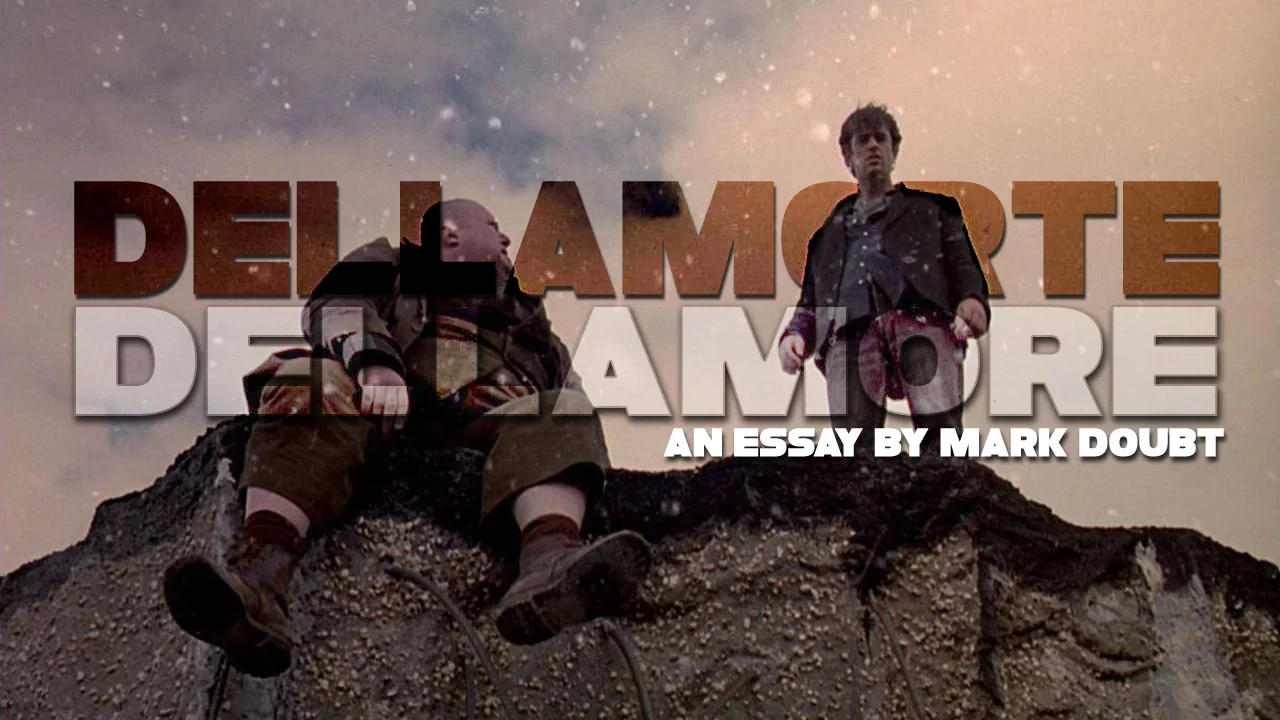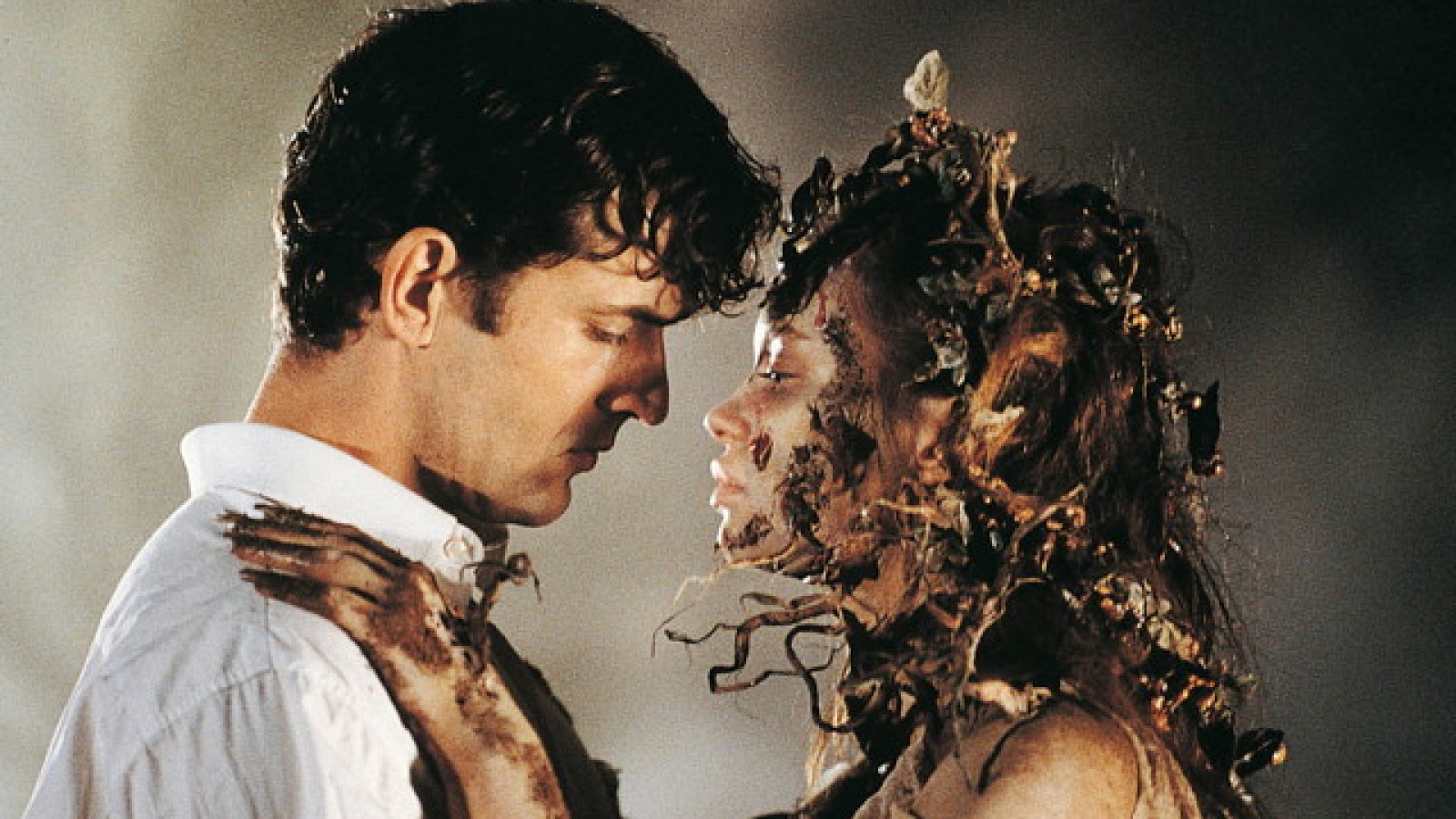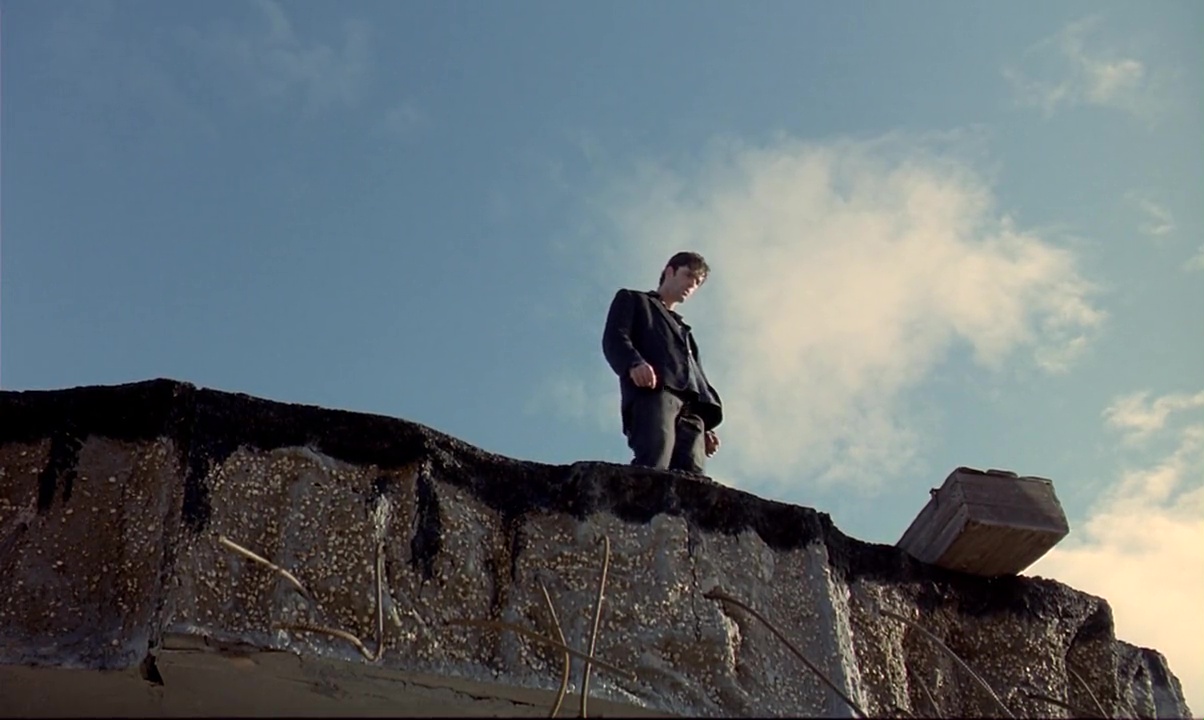By Mark Doubt
Who knows if the rest of the world even exists? (Dellamorte Dellamore, 1993)
"The horror genre has been for me an original way of taking an explicit visual and
visionary approach to directing.” — Michele Soavi
“The best film of 1993” – Martin Scorsese (cited by Keesey, 2011)
This essay
contains spoilers.
Dellamorte, Dellamore (Cemetery Man in the US) is arguably Michele Soavi’s masterpiece - the
finished product of his endeavours, bringing theme, style and technique from all the director’s previous films together into one glorious pay off. The man who studied under Dario Argento, Joe D’Amato and Terry Gilliam ably demonstrates his graduation, and in many respects surpasses not only his previous efforts but those of his mentors. It is a movie with ambition - a horror, a comedy, an existential romance, a technicolour fever dream. A love letter to death and a death letter to love.
Rupert Everett’s Francesco Dellamorte tends a cemetery, but his job is even more unusual than that would normally suggest. Francesco buries the dead knowing they will soon return to life, only to be killed by him once more. Thus, his work finds him trapped in a cycle of death. When She (the unfathomably beautiful Anna Falchi) enters his life, Francesco similarly finds himself trapped in a cycle of love. Thus is Francesco’s lot – constant turmoil, a cycle of events and emotions beyond his control. When She is attacked by the corpse of her dead husband, Francesco promises to love her forever…but is this in the traditional, “star-crossed lovers” sense, or because he knows She, like everyone else in the cemetery, will return from the dead for him to kill again?
Interestingly, Francesco’s idiosyncrasies don’t stop there. Throughout the movie, he is left feeling belittled by the sexual prowess of older men. When She refers to her elderly (now dead) husband as a “wonderful lover – incredible, tireless” he feels an instant inferiority. That the dead husband is soon responsible for coitus interruptus, spoiling Francesco’s fun with She, only adds to Francesco’s woes. A later incarnation of She says she can only love an impotent man – but when Francesco visits a doctor to make him impotent, he later finds that She
has made love to the elderly Mayor, a sexual awakening that means she no longer wants Francesco – foiled again. Clearly, Francesco’s psychosexual insecurities run deep, and are tied to his attitudes to life and death. Does he envy the dead? At one point it is obvious he does. Does he envy the elderly? Feel threatened by them? And for what? For being closer to death?
Dellamorte is so much more than a horror film. It has a wicked sense of humour, terror and
dread, and a hero suffering an existential crisis as the object of his affections returns again, and again – but he can never have her. Soavi himself considered that the film “doesn’t focus on scares, shocks, a killer or the murders’; instead/tension is built more towards the arrival at a caress, perhaps even a kiss, than bloody slaughter” (Keesey, 2011). Wracked with guilt, remorse and a profound sense of loss, Francesco loses grip of his sanity, and whether he knows the difference between the worlds of the living and the dead is questionable. He starts to kill the living, in hope that he will spare himself the trouble of having to kill them once they are dead, until he invites a visit from Death itself, the Reaper demanding Francesco stop meddling in affairs beyond his understanding.
Francesco’s mind continues to unravel, at an alarming rate, until the worlds of the dead and the living are completely blurred, and his existential crisis appears to affect the logic of the film itself – another play on themes to be found in Soavi’s previous films. At the film’s climax, a number of surreal sequences and locations only serve to further question Francesco’s sanity and the coherence of the movie’s narrative. The hospital where Francesco visits Franco, then indulges himself in a killing spree of nurses, doctors and religious personnel, is a maze of Escher staircases and wards bathed in obsidian shadow. At the movie’s ending, Francesco finally decides to leave, to see more of the world, only to find that it does not exist, the road travelled abruptly ending, the great unknown replaced with a giant abyss.
So what of the ending? What of the suddenly disrupted narrative, the labyrinthine
buildings and the post-apocalyptic wilderness? Is it even real? Is the movie
taking place within Francesco’s mind? The answer may lie in a snowglobe.
Director Michele Soavi
Like his mentor Argento, Soavi demonstrates an attraction to individuals and groups in isolated settings in his movies, and this can be observed through the analogy of the snow globe of nightmares – a pocket universe, created only to house the characters of the movie (pmcinern, 2015). Of course, every movie ever made is such; an existence formed only to house the director’s musings. Where certain movies differ is in an ironic awareness – where the creator is unafraid to show
the prismed edges of the universe, first to us, the audience, then to his or her own creations – the characters that dwell within the movie. Think of Peter Weir’s The Truman Show (1998), but with one difference – for Truman, there was an escape, into “the real world”. For Soavi’s characters, there is no escape from their confines, no infinite expanse beyond the edge of their observable universe (Soavi pushes this analogy further with his use of an actual snow globe at the start of the movie – it is one of the first things we see, its contents a chilling portent of the movie’s climax). It could therefore be argued that Francesco Dellamorte exists only within the confines of his own experiences – that his world is self-constructed and self-observed, and there is no escape from the Cemetery for Francesco because there is no escape from himself. This is observed in the final sequence, the abyss, and Francesco’s sudden descent into mute madness when faced with the all-too-finite edge of his universe.
Of course, one could argue that to seek an absolute explanation of the mysteries of Dellamorte Dellamore is perhaps to miss the point. Understanding of the movie may come not from unlocking its puzzle box but from unravelling and examining the feelings it awakens in the viewer (which leads my subconscious to make another link to the work of David Lynch; most notably the films Lost Highway, Mulholland Drive and Inland Empire – a trio of experiences for which true comprehension is only achieved through the conduit of emotion, rather than the cold, logical search for a narrative solution).
So what is Dellamorte Dellamore? Is it a high art zombie movie, or a psychosexual odyssey?
An essay on death, or a thesis on what it means to be alive? According to Soavi, it “is not about the fear of dying; its concern is to fear the living” (Russell, 2005). Indeed, Francesco seems to fear the living – he locks himself away in a cemetery, and while he executes his role there with a cool detachment, his interactions with the living provoke anxiety and dread. The film is considered “innovative, intelligent and highly personal (Palmerini and Mistretta, cited by Keesey, 2011), and “as philosophically rich and sensually aware as it is filled with zombie-blasting mayhem” (Thompson, 2006). It is perhaps the first film to bring a sense of real artistic credence to the Italian horror cycle since the high art horror of Mario Bava, decades earlier. Its gore set-pieces, while not quite as full on as other Italian horrors (or even other Soavi films), are stylized and memorable – from a busload of zombie boy scouts to a reanimated decapitated head.
The camerawork and editing are the most accomplished of Soavi’s oeuvre. The opening shot of the movie sees the camera slowly reverse-zoom from the nasal cavity of a skull, through the coils of a telephone cord as it rings – instantly recalling the stunning opening shot from Episode 11 of Twin Peaks (one final comparison to Lynch, although the shot in question was actually the brainchild of veteran television director Todd Holland), where the camera slowly spins as it executes a similar reverse zoom from the perforation of a ceiling tile. Throughout,
Soavi films with stylistic flourish, from a funeral scene shot from within the freshly dug grave, to an Escher-like staircase in a hospital filmed from above, leaving his visual fingerprints on every sequence. Manuel De Sica’s score (a last minute replacement for Goblin, who were originally supposed to score the movie) repeats the same compelling, heart wrenching refrain in a number of different styles with different instruments, creating an earworm that proves
difficult to escape.
One thing that Dellamorte definitely has is a lingering presence - its themes, its ideas and its mysteries will stay with the willing viewer long after the credits roll. Repeat viewings serve only to heighten this (while I cannot promise they bring a sense of closure; the repeat viewer will almost certainly reap further rewards).
Dellamorte Dellamore marks a zenith in the career of what might be the last of the Italian horror masters. Soavi grew up in the shadow of Mario Bava, alongside Lamberto Bava, Dario Argento and Lucio Fulci. That his movies come later than the others tends to have them viewed separately – both a blessing and a curse. Like Fulci, Soavi has produced work that transcends the genre(s) he works within, bringing a wealth of visual style alongside a pushing of the envelope as far as traditional narrative boundaries are concerned.
Would you like to hear even MORE about Dellamorte Dellamore paired with Fulci's Zombie? Check out BTVcasts newest episode about it.
HERE https://www.longlivethevoid.com/episodes/ep62pt2flesh
References and Further Reading
Creighton, Jolene (2014) What Lies Beyond the Edge of the Observable Universe? http://futurism.com/what-lies-beyond-the-edge-of-the-observable-universe/
Frazer,
Bryant (no date) Deep Focus – Dellamorte Dellamore http://www.deep-focus.com/flicker/dellamor.html
Keesey, D.
(2011), ‘Intertwinings of death and desire in Michele Soavi’s Dellamorte
Dellamore’, Horror Studies 2: 1, pp. 105-114.
Moran, Frank
(2015) Michele Soavi (interview) http://www.horrorgalore.com/interview/michele-soavi
pmcinern (2015)
Better Know a Director: Dario Argento. The second in a trilogy of giallo
masters. https://www.reddit.com/r/TrueFilm/comments/3kva2p/better_know_a_director_dario_argento_the_second/
pmcinern (2015) Better Know a Director: Michele Soavi. The third in a trilogy of giallo masters.
https://m.reddit.com/r/TrueFilm/comments/3l7iro/better_know_a_director_michele_soavi_the_third_in/
Pyke, Jim
(no date) The Films of Michele Soavi. http://www.stim.com/Stim-x/0596May/Automedia/soavi.html
Russell,
Jamie (2005) Book of the Dead: The Complete History of Zombie Cinema. Fab Press</
Thompson,
Nathaniel (ed.) (2006), DVD Delirium, vol. 1 redux, Godalming, UK: FAB
Mark Doubt is a big time horror fan who also likes to make art.
Check it out here
http://www.housebythecemetery.bigcartel.com/
and follow his Twitter











